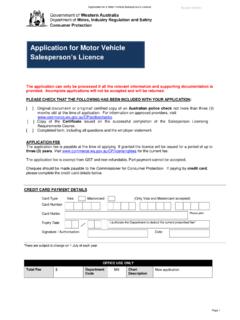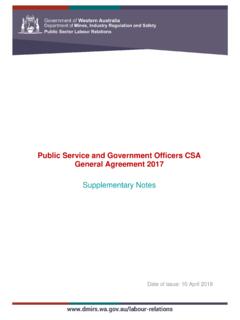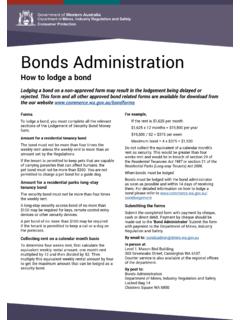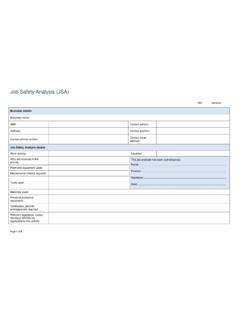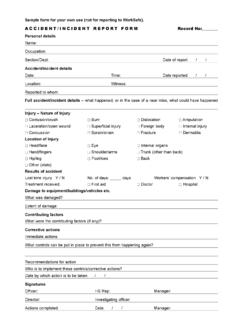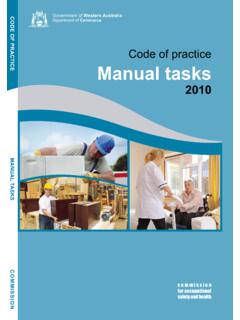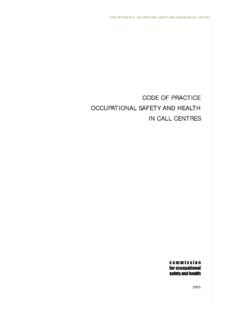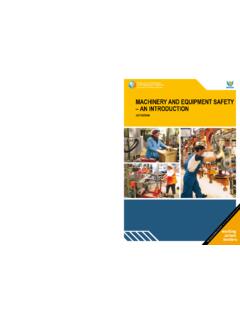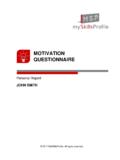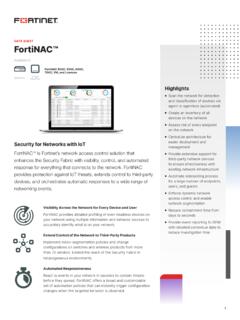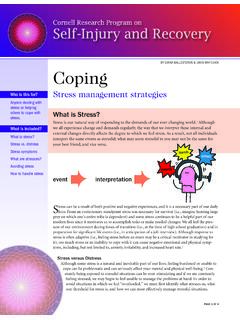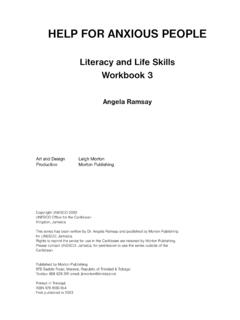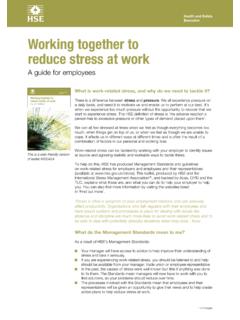Transcription of Psychologically Safe and Healthy Workplaces: Risk ...
1 Psychologically safe and Healthy Workplaces: Risk Management Approach Toolkit Psychologically safe and Healthy workplaces: Risk management toolkit 1 | P a g e A11111804 Disclaimer: The resources in this document may be useful in assisting workplaces in identifying, assessing and controlling psychological hazards such as stress and bullying related hazards in their workplace . Any risk management procedure should address all relevant risk factors and meet the consultative requirements of the Occupational Safety and Health Act 1984. Acknowledgement: Material written in this publication has been sourced from various key publications which are as follows: WorkSafe Victoria Comcare Health & Safety Executive, UK Copyright: Unless otherwise stated, copyright in all materials on this website is the property of the State of Western Australia.
2 In addition to any fair dealings permitted under the provisions of the Copyright Act 1968, material on this website may be reproduced or communicated to the public for research, study and private non-commercial use provided that the State of Western Australia is acknowledged as the copyright owner and the material is not altered. Enquires may be directed to: Department of Mines, Industry Regulation and Safety, Locked bag 14, CLOISTERS SQUARE, PERTH 6850 Or email: Psychologically safe and Healthy workplaces: Risk management toolkit 2 | P a g e A11111804 Table of contents 1. Psychologically Healthy and safe workplaces .. 3 2. Risk factors .. 3 3. Psychological symptoms and signs .. 4 4. Hazard identification .. 5 Analysing workplace data.
3 6 Direct observation .. 7 Employee survey .. 7 Examples of employee survey measures .. 8 Examples of health surveys / assessments .. 9 5. Risk management .. 10 6. Risk controls .. 10 Primary intervention .. 11 Secondary intervention .. 11 Tertiary intervention .. 11 Examples of primary, secondary and tertiary interventions .. 11 Appendix A - Psychological Hazard Investigation Report (sample) .. 13 Appendix B - Risk Assessment Tool (sample) .. 18 Appendix C - Employee Survey 31 Appendix D - Health Self-Report Measures .. 33 Appendix E - Leadership Development Tools .. 34 Psychologically safe and Healthy workplaces: Risk management toolkit 3 | P a g e A11111804 1. Psychologically Healthy and safe workplaces A Psychologically Healthy and safe workplace is one that promotes employees psychological well-being and proactively endeavours to prevent harm to employee psychological health.
4 Considerable research demonstrates that certain work-related factors impact upon employees responses to work and work conditions creating a risk of work-related stress and potentially causing psychological health problems and injuries. Work-related factors, otherwise known as psychological risk factors, include the manner in which work is carried out ( deadlines , workload, and work methods) and the context in which work occurs (including relationships and interactions with managers and supervisors, colleagues and co-workers, and clients or customers). Employees exposed to these psychological risk factors in the workplace are more likely to develop stress responses and mental health conditions. In addition, workplaces that do not address the psychological risk factors have the potential to make existing employee mental health conditions and stress responses worse.
5 Furthermore, workplaces that address psychological risk factors and create a Psychologically Healthy and safe workplace will have healthier, happier employees, and are likely to benefit in terms of performance, productivity, client satisfaction and retention of employees. 2. Risk factors When considering the effects of work-related stress, it is important to understand the characteristics of different levels of risk control within the workplace . Organisational: although there are many psychological risk factors that can lead to a psychological injury, there are eight psychological risk factors that can be controlled at an organisational level. They have been widely researched and are known to impact on employee well-being and adverse psychological health Environmental: physical and chemical stressors (as well as biological agents) can influence employees comfort and performance within the work environment and contribute to a stress response ( noise, temperature and humidity, lighting, vibration and air quality) Individual: people respond to the identified psychological risk factors differently and this can, in part, be related (or contributed) to by differences unique to individuals including previous experiences, coping ability, physiological and/or personality factors which are external to the work environment.
6 Differences in individual responses to stress do not reduce employers legal duty and responsibility to minimise exposure to work-related stress. These eight psychological risk factors which can be controlled at the organisational level are: Autonomy/control: the amount of authority the employee has over the way they do their job Job demands: the amount of workload the employee has to complete, this includes timelines for completing work Support: the level of support the employee perceives from management and colleagues Role conflict/ambiguity: the extent that the employee s tasks and duties are clearly defined ( understaffing can lead to employees doing tasks for more than one position) Relationships: the extent of good working relationships in the workplace .
7 This can include the presence of bullying and harassment issues in the workplace Change: involves planned and unplanned change in the work environment. Changes can occur at three levels: personal ( changes to position and responsibilities), management ( new Psychologically safe and Healthy workplaces: Risk management toolkit 4 | P a g e A11111804 supervisors or processes and procedures), and organisational ( takeover, restructure or redundancies) Rewards and recognition: involves rewarding employee efforts and recognising individual and team contributions and achievements within the organisation Organisational justice: refers to the perceptions of fairness about work procedures and how they are enacted.
8 It involves procedural fairness and relational fairness. Procedural fairness refers to how procedures are implemented within the organisation. Relational fairness refers to the degree of dignity and respect afforded to an employee during the process. Employees may also experience psychological injuries from aggressive or violent incidents that occur in the workplace . Psychological injuries from aggression and violence can occur from either cumulative events or as a result of a traumatic event. For more information on this topic, please refer to WorkSafe s Safety Topics and the Code of Practice: Violence, Aggression and Bullying at Work. 3. Psychological symptoms and signs Harm to employees health may occur when the employee does not have the ability to cope with the psychological risk factors placed upon them.
9 Individuals may differ in their ability to cope with the psychological risk factors. Some factors that influence the individual s ability to cope include previous experiences, coping styles, personality styles and available support. It is important to remember that because of individual differences, employees may react differently to stressful situations. What one employee may find stressful, another employee may not. Therefore, psychological risk factors and potential injuries should not be dismissed or disregarded on the sole basis that no employees or only one employee has been adversely affected. The initial response to personal or psychological risk factors is in itself not an injury.
10 The effects are usually of short duration and have no lasting effects once the stressful situation has passed. Acute or chronic harm to health may result when the employee is unable to cope with persistent and sustained exposure over a long period of time. When an employee experiences adverse health effects from psychological risk factors they may experience symptoms and signs which can be categorised as: Physical, Emotional, Cognitive, and Behavioural. Table 1 displays the signs and symptoms within each of the categories. Psychologically safe and Healthy workplaces: Risk management toolkit 5 | P a g e A11111804 Table 1. Signs and symptoms Physical Cognitive Emotional Behavioural Increased heart rate (pounding) Elevated blood pressure Sweaty palms.
